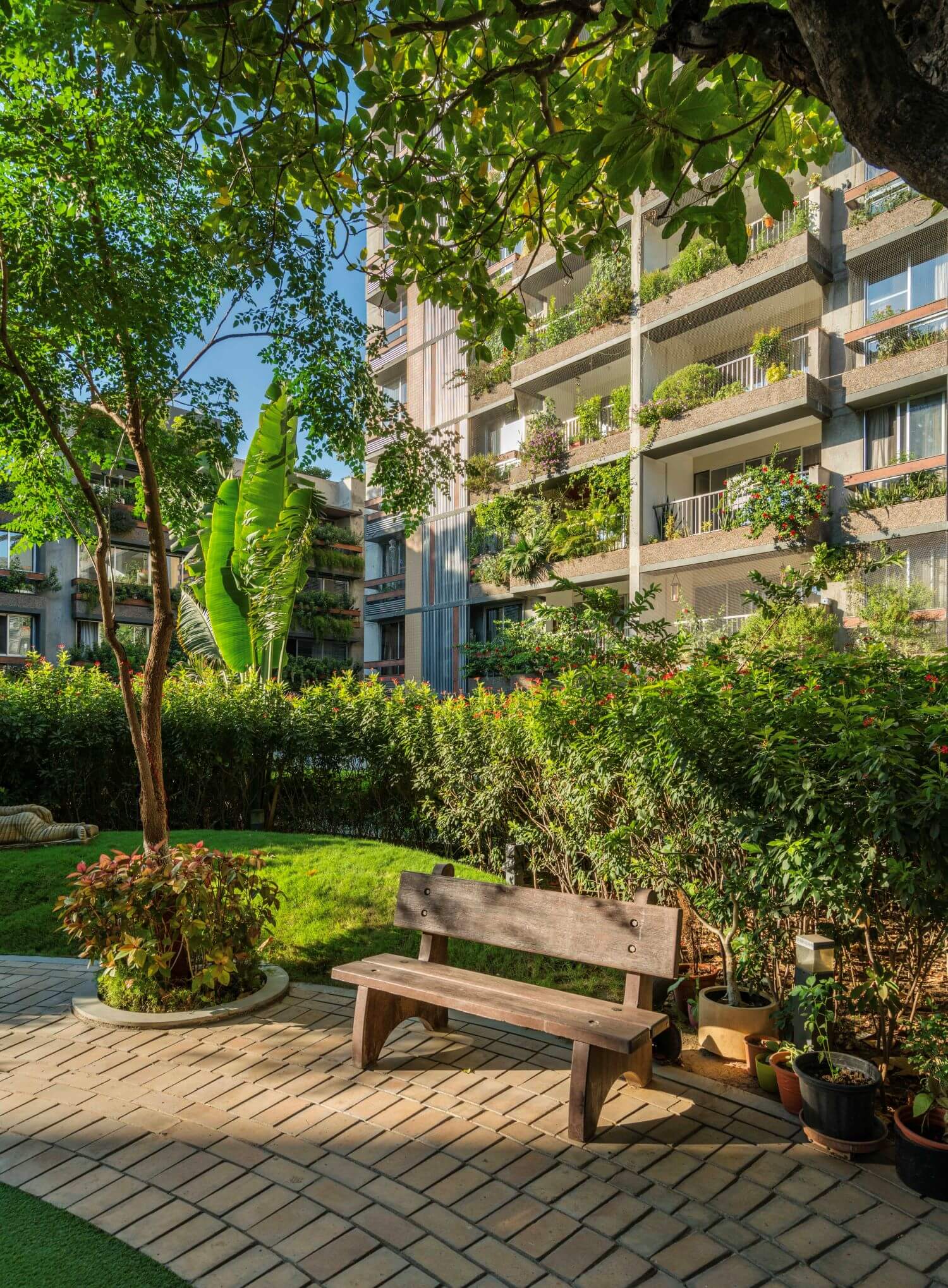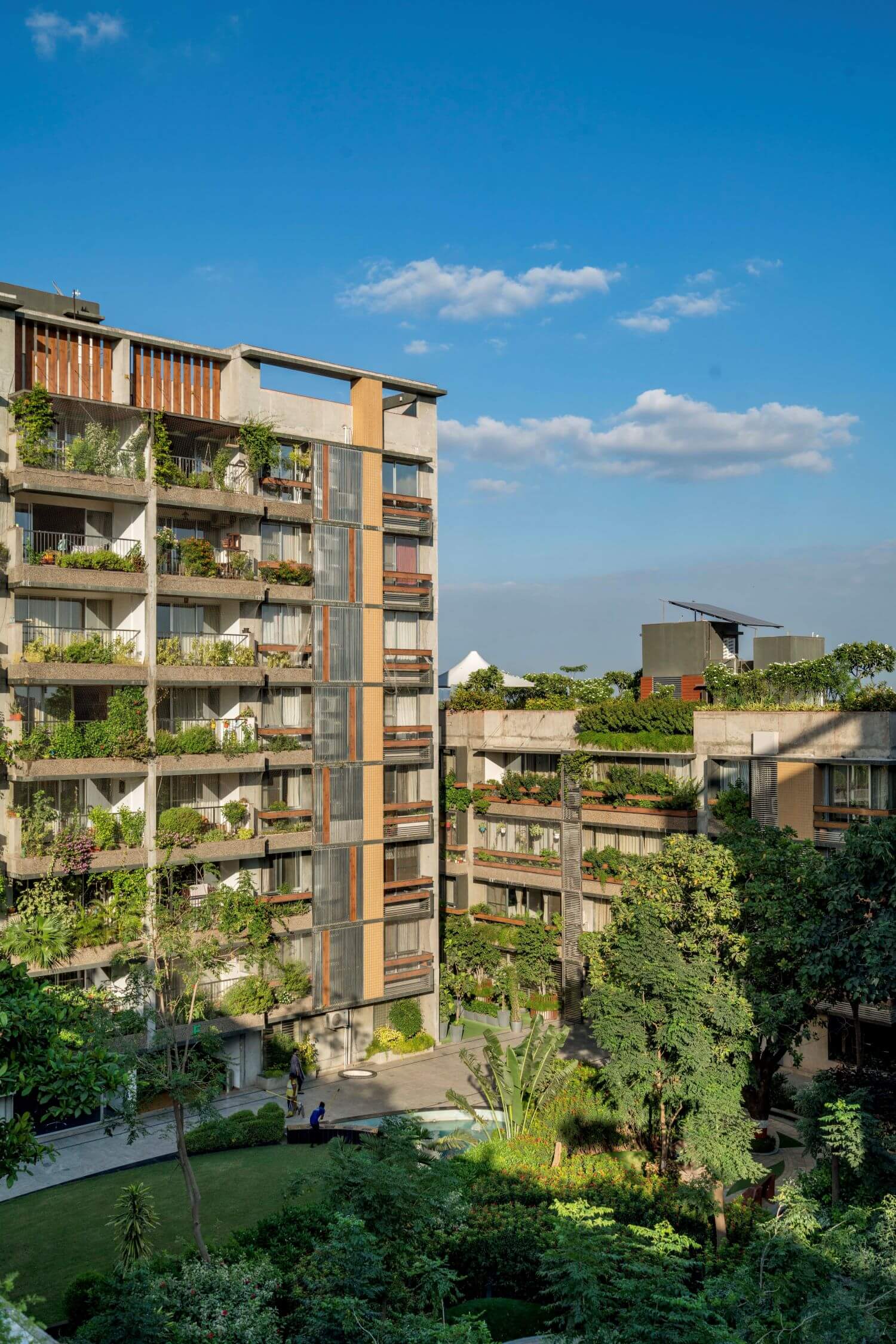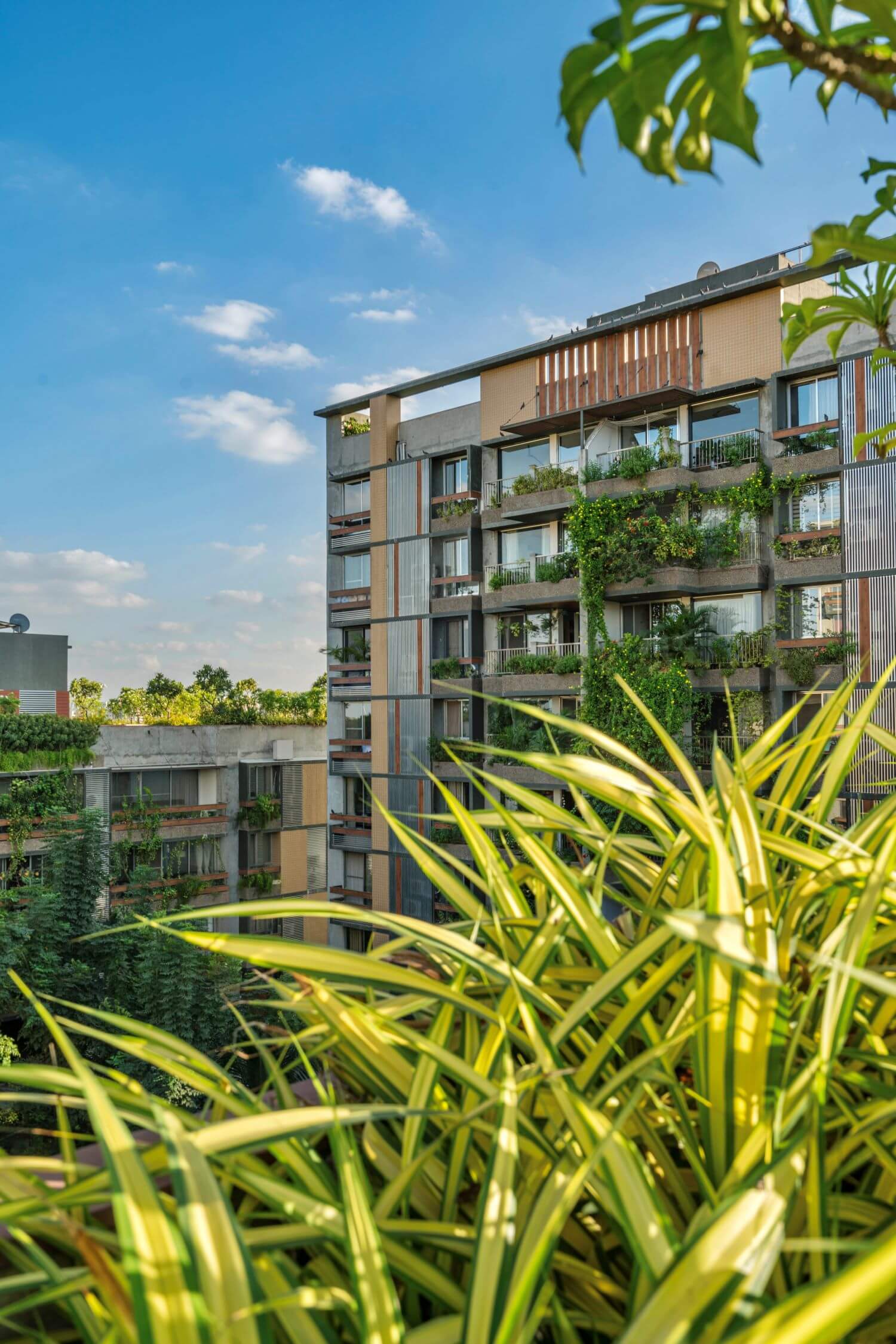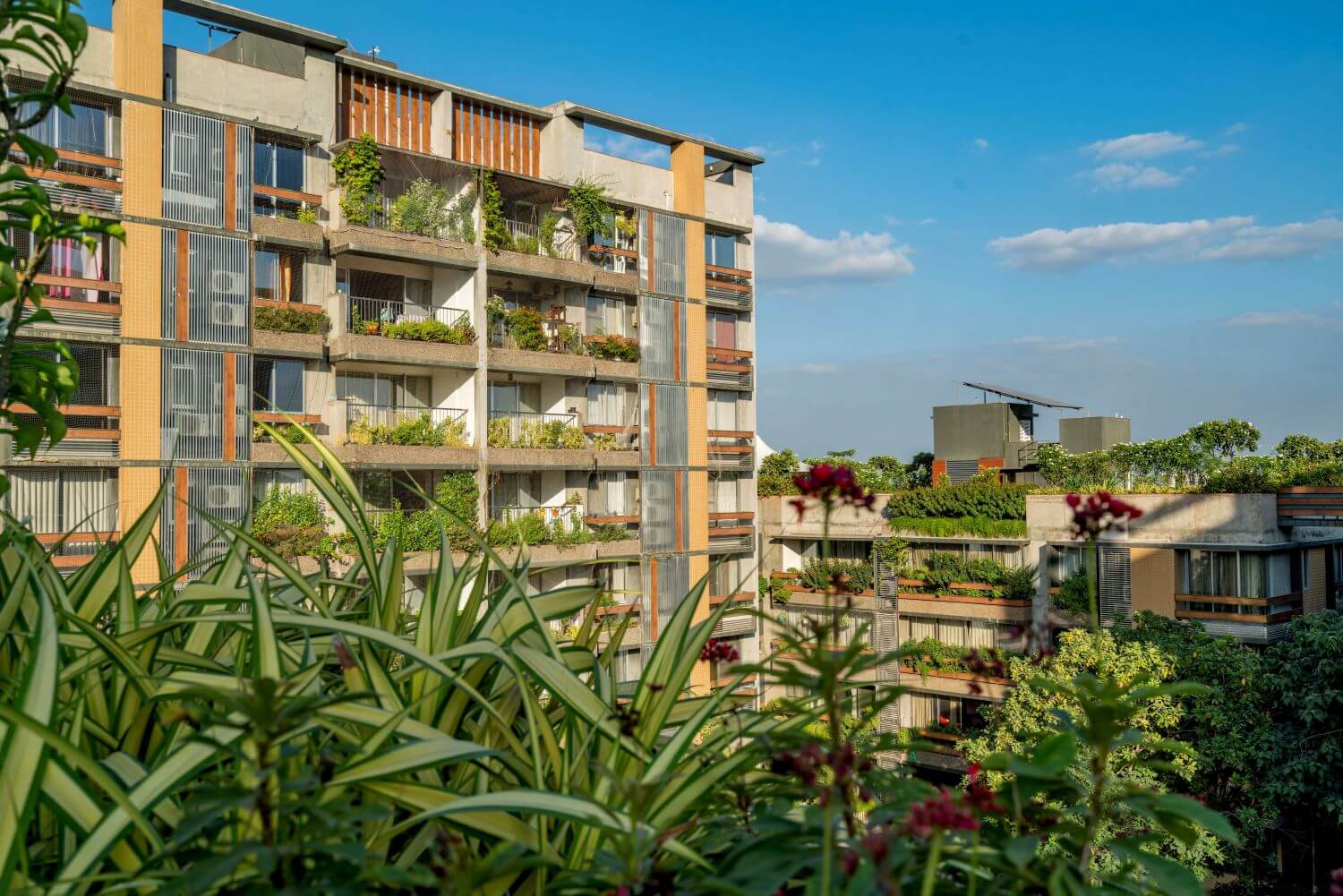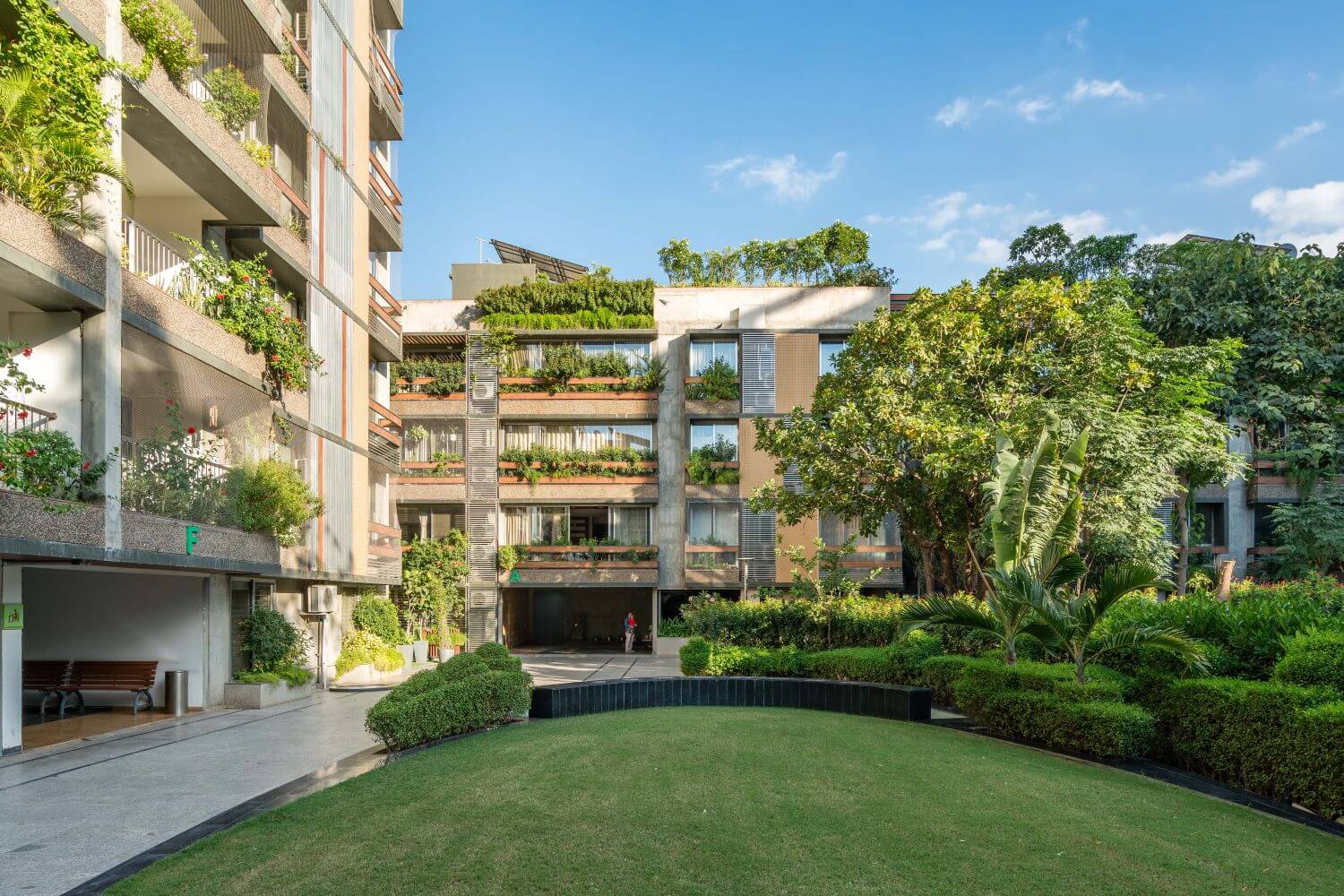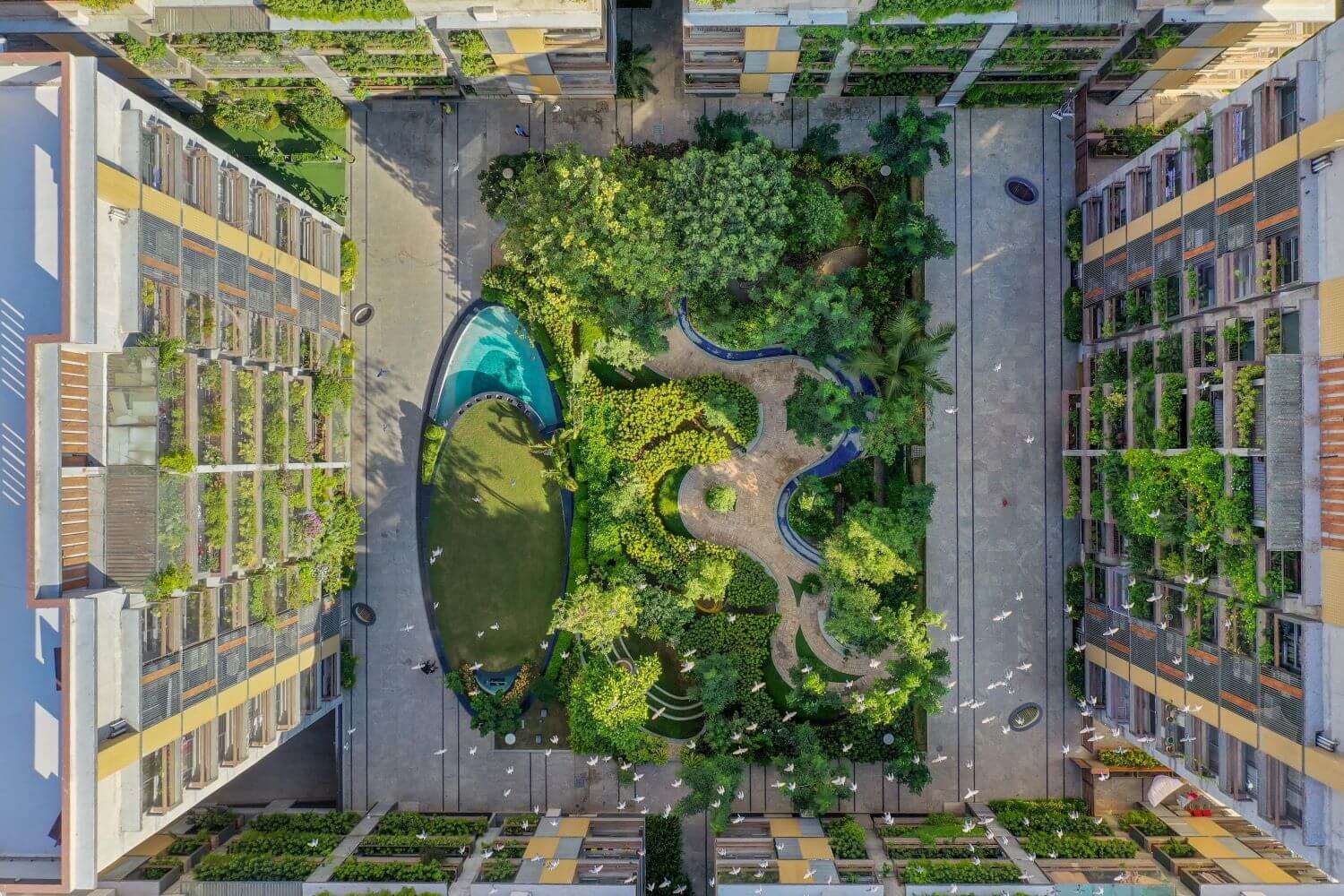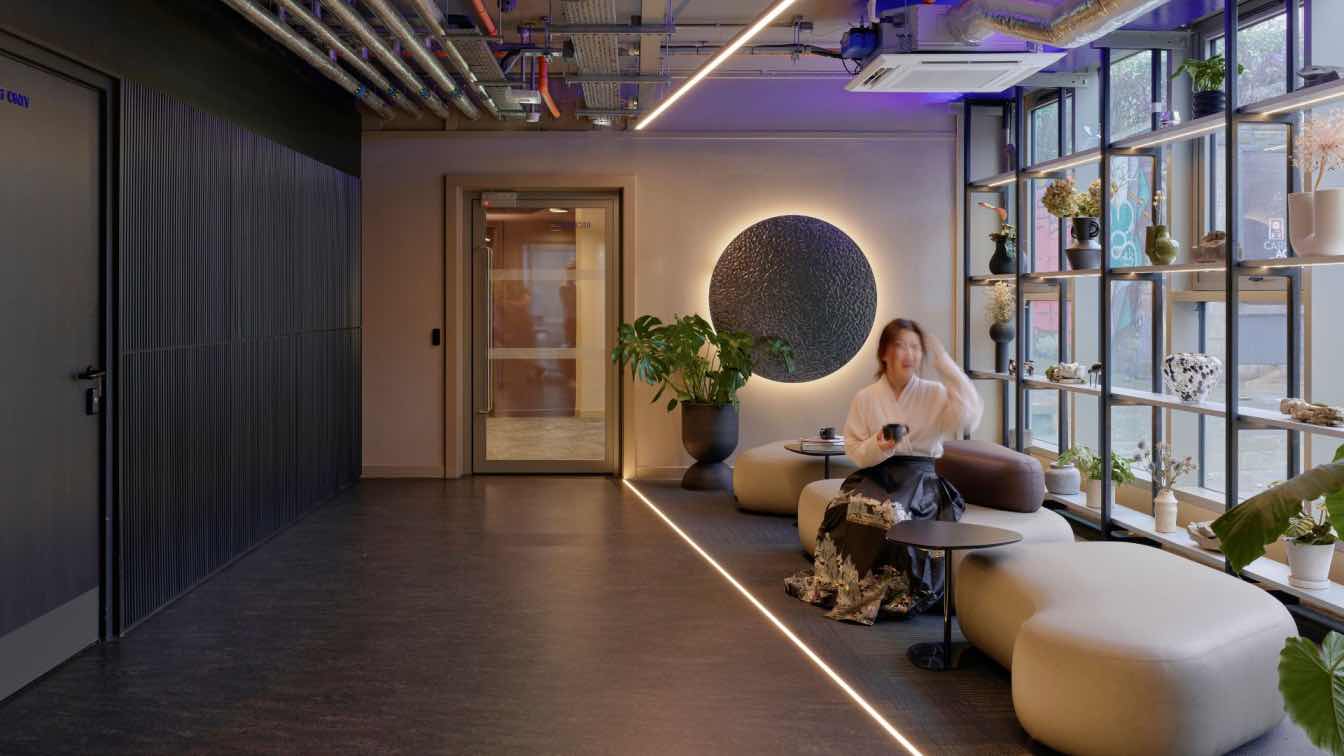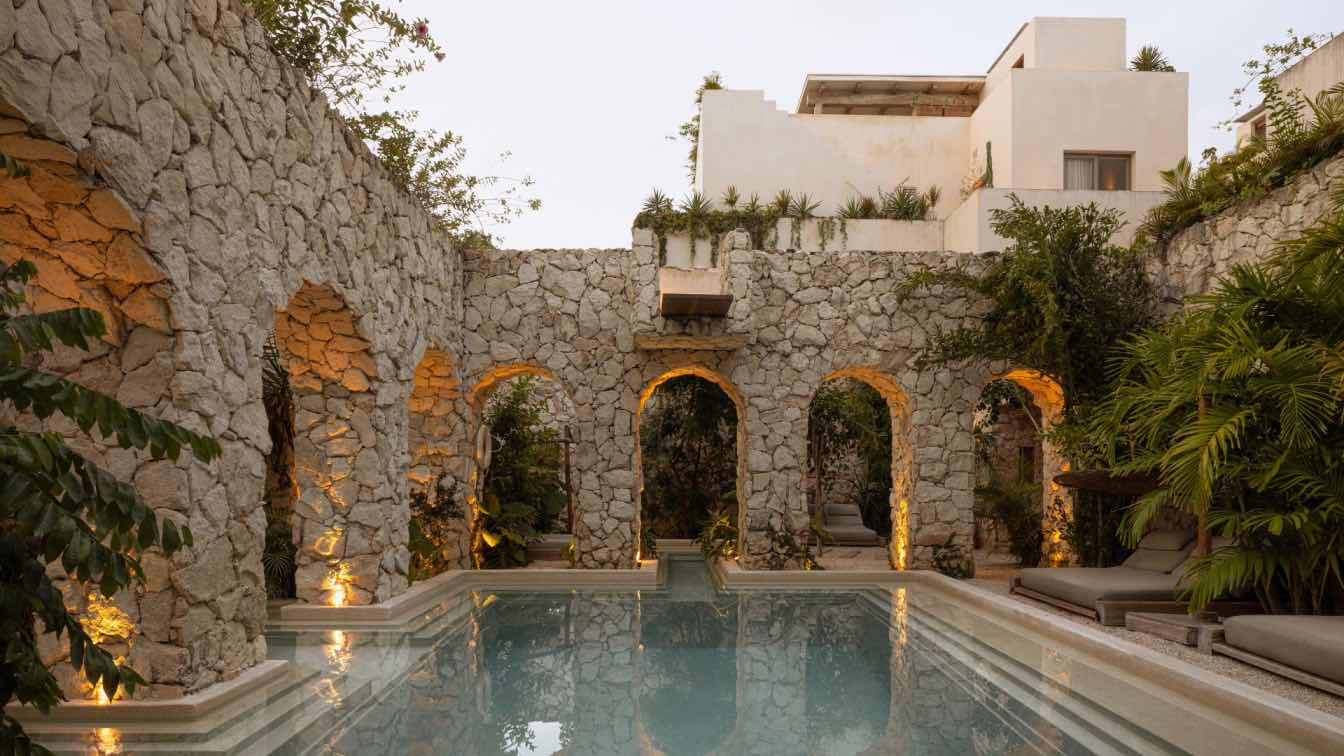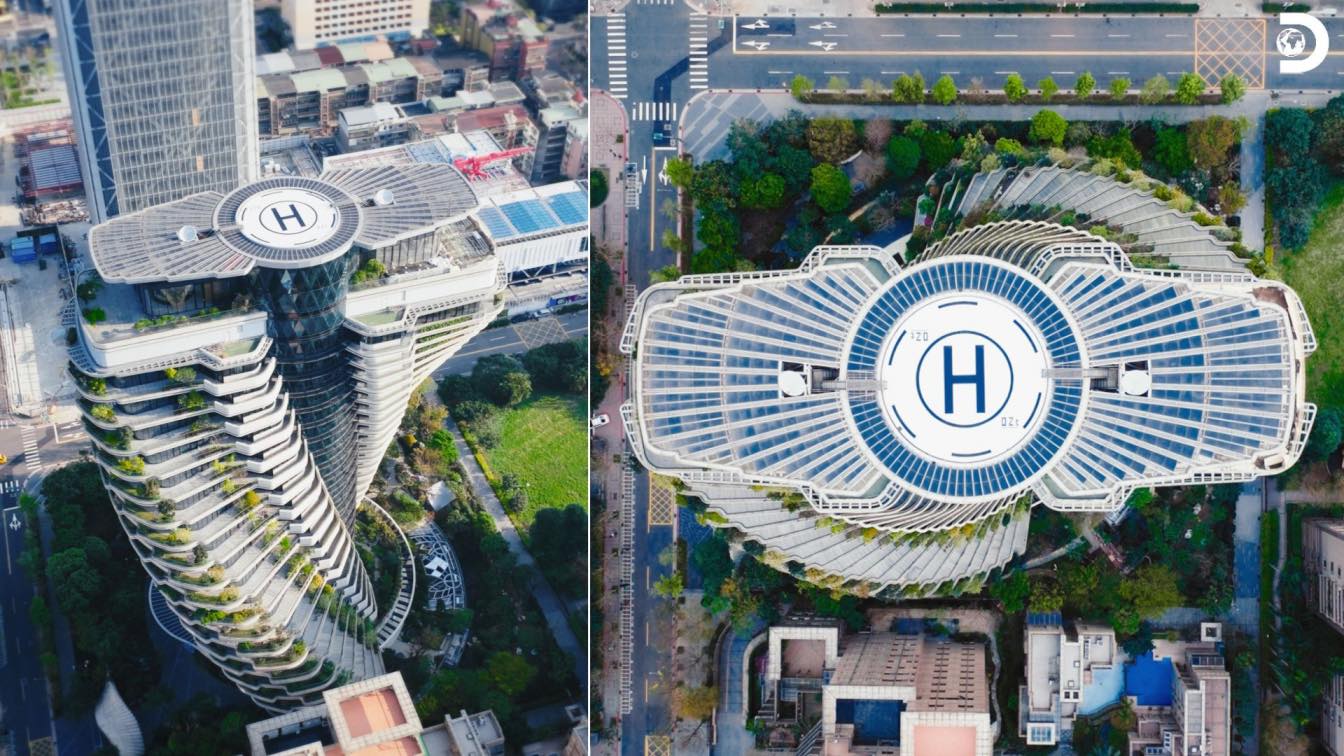tHE gRID Architects: Gujarat’s – India- First IGBC Green Home Platinum Rating Housing Project.
Vision
Sustainable compact green building. Endorse and encourage community living. Inclusive of quality public spaces. To connect with the earth, sky, water, and nature. Biophilic architecture inspired: living with, and in nature. It is designed with organic, natural elements that appeals to our senses and tendency to find comfort and inspiration to the natural settings. Architecture space fully integrated living plants and greenery composed with organic materials. Fresh air and warm sunlight. Purposeful built project which seeks to focus on human’s inherent attraction to nature and natural processes with numerous benefits to our health and well-being.
Ideology
The imminent need to build homes to reduce carbon footprint. To design an energy-efficient building. The approach was to have living spaces organized and planned to facilitate multi-family needs and revitalizing public and private spaces. The incredible journey to a residential abode amidst nature.
Project note
The design is a spontaneous response to the site surroundings. Its genesis lies in the need to integrate social housing into the urban fabric and the architects’ ethical obligations towards the society to endorse community living for a positive impact on the values and lifestyles of the human race.
The design philosophy embraces the green movement and encourages atmospheric settings for relaxation. The driving force was the focus on having a sustainable, energy-efficient residential housing project that would also endorse high-quality community living. The design of the buildings was resolved in such a way that there were two high-rise towers on the north and the south, and two low-rise blocks on the east and west. The result labyrinth of spaces, in combination with energy conservation systems and careful selection of materials, helped in the continuous flow of wind and protected the community from direct heat from the south (the high-rise to the north was created to balance the design forms). The buildings are quite linear and are mostly composed of cubes and cuboids as these geometries allow optimization of space.
The volumetric, grid-based complexity of the structures is tautly balanced and simplified by the central garden, which is dominated by curvilinear forms. All the units are meticulously planned and have a view of this naturally integrated green space filled with birdsong, rippling water (via channels and waterbodies), interspersed with pathways and benches. The hardscaping is molded as part of the artistically planned landscape. The organic forms of the pathway intermingle with rhythmically incorporated water channels. Placed strategically, are benches rendered from waste pipes, which acts as its structural member as well as a planter. The two high-rise towers bestow a sense of protection to the central garden. This space thus creates a festive cultural environment and adds a sense of calm to life within the community. Terrace gardens further help in creating a large social area and sit-outs for gatherings.

The gated community features three layers of greenery: the landscaping; the huge trees; and the terraces, which have been converted into gardens, activity zones and a hangout place. The ground floor is a car-free zone, and all the blocks on the ground level are like a huge clubhouse and a zone for interaction as there are reading areas and indoor games, a gym, a home theatre and walkways. Interconnections and interdependencies between the built and unbuilt a paradigm shift from sustainable design to regenerative design, which is to get into a positive cycle in which everything we do, we're trying to have a positive impact – in terms of restoring ecosystems, taking carbon out of the atmosphere or reducing carbon emission and so on.
The objective of designing an energy-efficient housing community led the architects towards researching and using regional materials and local labour. The material palette features sandstone, exposed concrete, Stonecrete, aluminum powder-coated louvres, glass. It also uses grey water recycling strategies that reconnect the urban residents to the natural water cycle and increases the productivity of the ecosystems. The design was developed in shear wall structure to free up space for the residential units and car parks. All car parks have been accommodated in the basement.
The narrative and calculation provided in the template indicates that total site area is 7102 sq.m and the area landscaped on the ground is 2,228 sq.m which amounts to 31% of the site area. The submittal includes a landscape plan showing vegetated areas on ground.
This housing project benefits from the ideology that it is people who occupy a home and make it beautiful. The design deliberation centered around finding an equilibrium in the structure, landscape and a sequence sensitive to human interaction. The planning thrived on creating a sense of ‘arriving home’ and creating a programme in which public spaces became extended living areas.
To create a relationship with nature and a design beyond sustainable architecture that minimizes damage to the planet and help restore the environment. we can look for examples at the characteristics of nature to inspire very efficient structures. Analyzing ecosystem characteristics and adapting conventional systems to mimic them. The goal is to design new housing that is not only sustainable, low in embodied energy, but also reduces carbon emissions.

GREEN DATA
1. Environmental category
The report is organized into five environmental categories as defined by IGBC. Materials which include – Site Selection and Planning, Water Efficiency, Energy Efficiency and Indoor Environmental Quality. The category of Innovation and Design Process is also included.
2. IGBC Mandatory Requirement
Green Homes should meet certain mandatory requirements which are non-negotiable. These mandatory requirements should be addressed immediately by the team
3. IGBC Credits
The environmental categories are subdivided into credits, which are based on desired performance goals within each category. An assessment of whether the credit is earned, pending, or rejected is made and a narrative describes the basis for the assessment
A) Measures during construction included site barricading, protection of existing vegetation, water sprinkling to reduce dust and sedimentation control using an existing swimming pool for settling, sedimentation basins and wheel washing. Post occupancy measures include implementation of storm water drains and landscaping on site.

B) The following data for green statistics
1. Green building materials, climatology and wind direction were the main aspects. the green design protects against pollution. reduce the urban impact environmentally.
2. The narrative and calculation provided in the template indicates that total site area is 7102 sq.m and the area landscaped on the ground is 2,228 sq.m which amounts to 31% of the site area. The submittal includes a landscape plan showing vegetated areas on ground
3. there is minimalistic use of materials and regional materials are incorporated.
4. urban heat island effect - the building designs were resolved in such a way that there were two high rise towers on the north and south and two low rise blocks on east and west protecting the central area from the direct heat. this shading strategy in combination with energy conservation systems and careful selection of materials helped in the continuous flow of wind and saving from the extreme heat of the south direction. the urban heat island effect has been reduced by application of china mosaic to entire exposed roof area.
5. The project has an energy efficient building envelope with u value. reflective glass is used which cuts down on the heat component and allows up to 67% light indoors. led lights are put into services to have a light power density 30% less than the base case. it also has 5-star air-conditioning which is free of cfcs. common area has sensor lights. energy use on major circuits is monitored using energy meters. all light fixtures are selected as per lpd(light per density). solar panels- providing electricity to all common infrastructure foyer and landscape.
6. Project has installed LED light fixtures in all common exterior and interior areas including staircase, life lobbies and achieved LPD more than 30% over base case.
the following energy efficient equipment:
a. Level controllers in overhead tanks
b. Energy efficient elevators with group control
c. ISI rated pumps with minimum efficiency of 60% if over 3 HP
d. ISI rated motors with minimum efficiency of 75% if over 3 HP
7. the structure of the houses is very linear mostly composed of cubes and cuboids. the linear shapes are used as it allows maximum usage of space.
8. all regional materials are used, material use by cost has recycled content, preventing the use of virgin material. overall construction material has been produced / manufactured / quarried within 400kms of the site, reducing carbon footprint associated with shipping of construction materials. intrinsic detailing was meditated upon. purposeful and sensitive element range was put together to encompass environmentally friendly relevant materials. the construction waste material from previous sites is used. the ss pipes are used in common stair railing. the brick and concrete waste are used in land refilling and the steel salvage is used in basement raft slab.
9. the material palette consisted of, exposed rcc (concrete), high pressure laminate, fsc certified wood, sandstone, stonecrete, aluminum powder coated louvers, glass, granite and vitrified tiles and eco-friendly colors. the systemized use of green building materials reduces the environmental impact of extraction, transportation, installation etc. green materials also enhance the indoor air quality as they are non-toxic and have minimal chemical emission and low moisture resistance. reduced maintenance and replacement costs over the life of the building.
10. installation etc. green materials also enhance the indoor air quality as they are non-toxic and have minimal chemical emission and low moisture resistance. reduced maintenance/ replacement costs over the life of the building.
11. The IGBC Green Homes Template and narrative submitted states that the project has access to the following basic amenities within a radius of 1 km of the project site: Bank, ATM, grocery, school, crèche, fitness centre, pharmacy, restaurant, place of worship, park. Supporting documents include photographs of the amenities and a Google map of the area showing the project site and the amenities.
12. the site also contemplates needs of the differently abled people and states equal importance to them by providing uniform floor levels with ramps in 1:20 scale where needed and there is provision for accessible toilets, dedicated parking areas are also rendered. the elevators are differently abled friendly accentuated with braille buttons and voice assistance which allows for accessibility and thus creates a barrier free design.
13. the ground floor is a vehicle free zone and acts as huge dynamic clubhouse, gathering place and the epicenter is the central garden- courtyard, comprising of sit outs, water body and water channels
14. The IGBC Green homes template and narrative submitted state that the project is required to provide 204 car parking spaces for residents as per the local parking code and project has provided 204 car parking spaces for residents and 21 car parking spaces for visitors (10.2% of required parking for residents).
15. the design was developed in monolithic rcc sheer wall structure with raft foundation, so essentially more space in planning of the units and car parks. Project has efficient wall with U value of 0.75 W/sq.m deg K. The wall is completely of poured concrete acting as shear wall
16. there is a dedicated basement parking facility for all vehicles and electric charging facility has been provided for up to 22 users, promoting the use of electric vehicles, thereby providing electric charging facility to 10.7% of the total parking provided.
17. The narrative and rainwater harvesting calculations indicate that impervious area of both roof and non-roof is 5,075 sq.m. The average rainfall of last five years is 30mm. The total runoff is 152 CuM. The project has designed rainwater harvesting pits each with volume of 61 CuM. Project has proposed three rainwater harvesting pits, hence total volume captured is 183 CuM
18. The site area maintains natural topography. Topsoil is stored for landscaping use. site soil erosion is controlled by vegetation. The site area is 7102 sq.m and total landscaped area is 2228 sq.m and area covered with turf area of 398 sq.m, which is around 17.8%. that site area is 7102 sq.m and total landscaped area is 2228 sq.m and area covered with drought tolerant species is 1830 sq.m, which is around 82%.
19. grey water recycling reconnects the urban residents to the natural water cycle and increases the productivity of the ecosystems. 100% of the grey water generated will be treated on-site. 100% of which will be treated on-site by a 50 KLD STP. that the quantity of treated wastewater available is adequate to fulfil 100% of the landscape watering requirement.
20. for both water and energy conservation rainwater harvesting system is integrated to capture 183 cum water which is self-reliant for the needs of residents. regulated flow cp fittings are installed to save in excess of 20% water. water meters are installed for measuring hot water consumption, landscape water consumption and the reuse of treated wastewater
21. RWH is an excellent source of water for landscape irrigation. irrigation systems is deployed to save water by using drip irrigation automated.
22. the balconies have been incorporated in the architectural design with rcc planters and the greenery selected is relevant to the climate. the planters for every apartment and also have a supply of water through sprinkler system at regular intervals automated and moisture sensor. water use on major circuits is monitored by water meters. all faucets 8 to 12 lpm fixtures in bathrooms. dual flushing system.
23. over 82% of plants used are native adaptive species which are drought tolerant and promote local biodiversity. there has been a consideration for oxygen generating plants. the fruit bearing plants have also been incorporated to encourage birds and insects and thus create a natural environment
24. terrace gardens were integrated creating a large social area and sit outs for gatherings with water bodies.
25. the project has implemented the following water conservation measures in its irrigation system:
a. Central shut-off valve
b. Segregation of turf and other plant species
c. Pressure regulating device
d. Drip irrigation for entire landscape
26. that the project has installed only BEE 3-star air-conditioners in the building. The air- conditioners are CFC free.
27. The narrative submitted states that three bins have been provided to each dwelling unit to separately collect organic, paper and plastic wastes and additional bins have been provided in common areas to collect metals, e-waste, lamps. The narrative states that organic waste is processed on site while other types of recyclable wastes are diverted via recyclers.
28. indicate that 29,900 tons of construction waste was generated in the project of which 100% of the waste (i.e. 29,900 tons) has been diverted from being sent to landfills.
29. The submitted narrative and calculations indicate that the quantity of organic waste generated per day from this project is estimated to be 110 kgs. The narrative states that the project has installed an organic waste bins that is capable of processing 110kg of organic waste per day. The submittal includes a brochure of the zero waste bins.
30. that the project has sourced materials with recycled content which constitutes to approximately 30% of total materials by cost, i.e. the value of recycled material is Rs.403 lakhs out of a total material value of Rs.1336 lakhs. The recycled content materials sourced include Shear wall, reinforcement, steel, vitrified tiles, glass,
31. approximately 100% of the new wood used in the project was FSC Certified.
32. smoking is prohibited in the common areas project, No Smoking signage installed.
33. all rooms achieve the minimum required ventilation ratios
34. that low VOC paints, sealants and adhesives were used within the interiors of the project.







